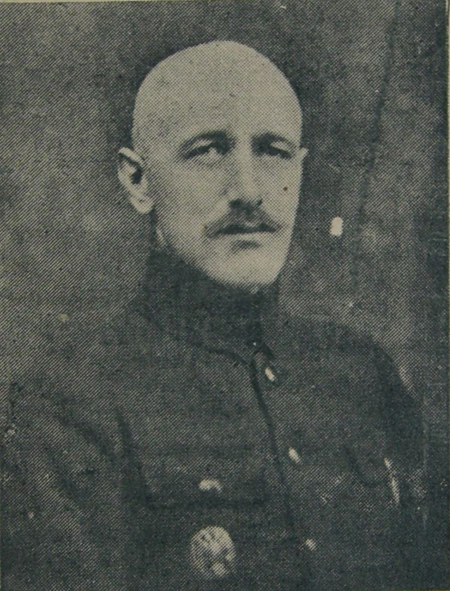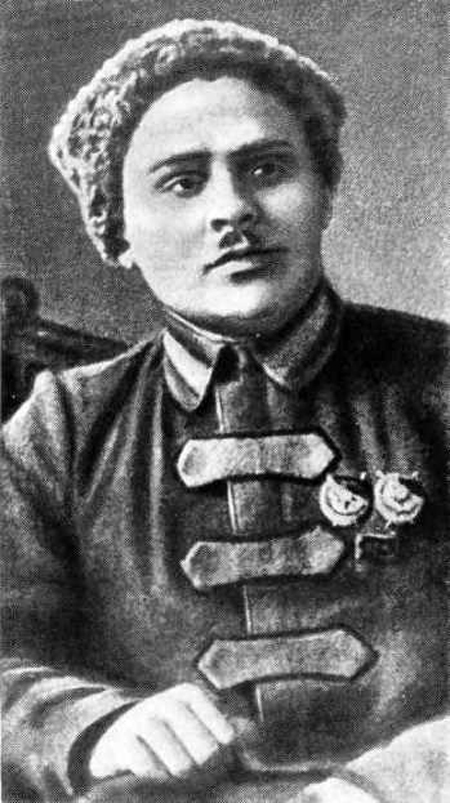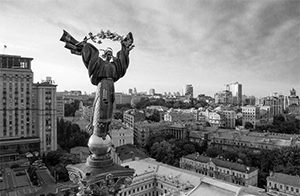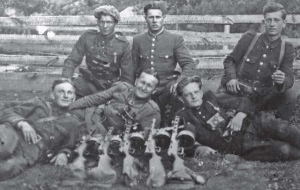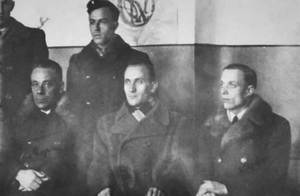Freedom, or Death! Haidamakas from Academy
Ataman Petliura gathered all of us and spoke: “We need to spare no effort, just one more time!” That was a crazy attack — violent and ruthless. Many Haidamakas perished in this battle, no one escaped a bullet.

On January 13 (Julian calendar), 1918, a state of siege was declared in Kyiv. That same day, at about 10 pm, the dismissed Minister Symon Petliura and Captain Oleksander Udovychenko took the last streetcar from Khreshchatyk to Podil, and proceeded to the quarters of 2nd Ukrainian Military School.
They were looking for recruits to replenish troops of Haidamaka Kish (unit — tr.) of Sloboda Ukraine, headed by Petliura.
Despite the late hour (Petliura and Udovychenko arrived at 11 pm), school administration managed to gather about 200 cadets and officers in the main hall.
Petliura took the stage:
"The future of free Ukraine, cadets, today of all days, and not in a year, the fate of you Motherland is in your hands! It’s today or never that you will protect Ukraine and freedom, and perform a miracle!
Four days ago Bolshevik tyranny destroyed the last hope of all honest citizens of the Russian Republic — it dispersed the Constituent Assembly in Petrograd! This was accompanied by shooting of the capital residents’ rally, and murder of the deputies of Constituent Assembly.
If Bolsheviks enter Kyiv, they will not allow for the assembly of the Ukrainian Constituent Diet, which, as you all know, is scheduled for late January. Bolsheviks will shoot your officers, as it happened in Kharkiv in December, they will kill your family and close ones, and they will turn you into slaves and second-class citizens. You will be scared of your own shadow!
You are the only ones who can protect perpetual mottos: Freedom, Equality, Brotherhood! There is not enough force on the frontline right now to stop the Red Horde. I believe that only young lions with a cry: "Glory to Ukraine!" will go into a fight against machine-guns, and will change the history.
I have already gathered in Kyiv the Haidamaka Kish of Sloboda Ukraine that will free the East of our Republic… I don’t order you; I call on to you, cadets, come, fight in my army and enlist to the Black Haidamaka Kuren [batallion — tr.] of the Sloboda Kish! If you believe me, if you feel obligation to Ukraine — you will stand under my banners! Freedom or death! Motherland or death!
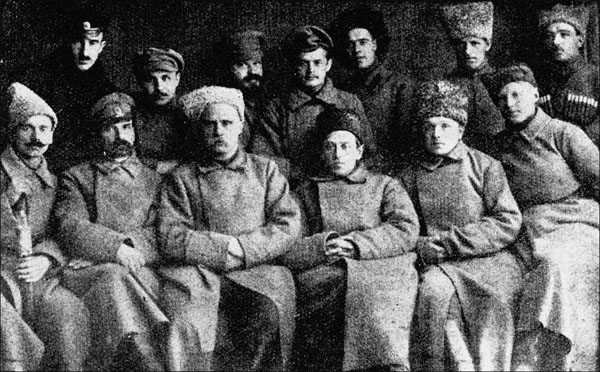 |
| Leaders of the Haidamaka Kish of Sloboda Ukraine |
By drawing of lots 148-150 cadets headed by Sotnik [Captain — tr.] Blavatny enlisted to Haidamaka Kish, and the rest remained at school. Cadets made their own black hat and coat insignia - and became the Black Haidamaka Battalion.
The 2nd Ukrainian Military School was open November 1, 1917, on the base of the 5th Kyiv Junior Officer Academy. Here, Ukrainian cadets who had not completed their education were transferred as senior students from different Russian military schools. Junior students were enlisted from among gymnasium and college students. Total number of cadets was a little over 400. Senior class graduated in December of 1917. The School was located on the premises of the Kyiv Theological Academy (currently building 1 of "Kyiv-Mohyla Academy"), and Brotherhood Monastery. The school was headed by Lt.-Col. Kliopa.
Before 1918, school cadets were considered reserve troops and did not take part in the First Ukrainian War against Bolsheviks. Starting November 15, 1917, the cadets guarded the State Treasury, telegraph, electric power plants, and other strategically significant sites.
However, in the first days of 1918, the incursion of Russian SFSR Army threatened the very capital of the Ukrainian People’s Republic (UNR).
There remained fewer and fewer reliable troops, while military authorities were scattered and uncoordinated, which worsened the already critical situation. Local Red Guard time and time again displayed their military might, manifesting their readiness to join the Soviet troops.
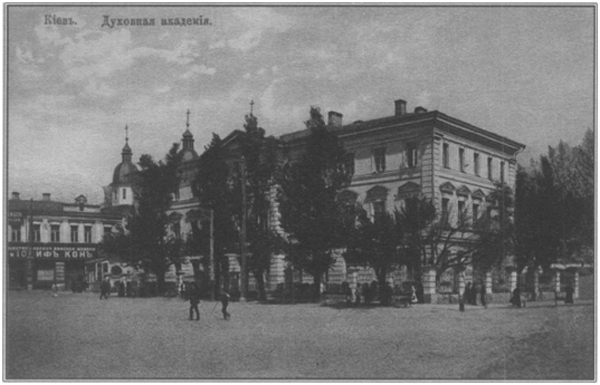 |
|
Campus of the Kyiv Theological Academy that in December 1917 – January 1918 hosted the 2nd Ukrainian Military School. Today, one of the buildings of the National University of Kyiv-Mohyla Academy. Postcard of the early XX century. From the book "Officer Corps of the Army of the Ukrainian People’s Republic (1917—1921)" by Yaroslav Tynchenko. — Book two. |
Preparations for the departure took the Brigade the whole day. Only on January 15 (28) the Haidamaka Brigade left for the front, to guard points of railway access to Kyiv from direction of Poltava and Chernigiv.
Apart from his own troops, the 1st Company of Galicia and Bukovyna Battalion (the 1st Battalion) of Sich Riflemen was under command of Symon Petliura.
They secured position at Bobryk station along Chernigiv railway rout. Black Haidamakas and a platoon of Sich Riflemen arrived at Kononivka Station, East of Yagotyn, were Haidamaka vanguard was positioned for several days. Cadets of the 2-d Ukrainian Military School made an improvised "armoured train" with available train cars.
On January 16 (29), 1918, while few dozen kilometers away the Ukrainian troops were holding of attacks of Muravyov troops, at Kononivka Station, Black Haidamakas (150 bayonets) and platoon of Sich Riflemen (30-40 bayonets) were withholding attacks of the 1st Bolshevik "Army" of Pavel Yegorov, namely its Kharkiv march column lead by Belenkevich (over 1100 bayonets).
Black Haidamakas only had one cannon, which they mounted on railway platform. In front of the station, Haidamakas and Sich Riflemen dug trenches. In late afternoon Bolshevik troops — Donetsk and Kharkiv Red Guard — lined up on both sides of the railway. They launched an attack on the position of the UNR troops.
"Black Haidamakas and Sich Riflemen defended Kononivka for quite some time, before the enemy almost completely encircled them. Then, they jumped on a train, and, shooting back in every direction, they, in the very last minute left the station unharmed, before Bolsheviks managed to destroy rails on their rout to Kyiv", — wrote Sich Riflemen and formation chronicler Vasyl Kuchabsky.
They managed to successfully defend Kononivka Station for prolonged period of time due to the fact that when Ukrainian troops fired their first shots, three lines of the Red Guard broke down and piled together getting in line of friendly fire.
 |
| Vasyl Kuchabsky – Ukrainian historian, publicist, politician, public and military leader |
While Ukrainian troops were trying to hold of the attacks of the RSFSR Army, on January 16 (29), Kyiv Red Guard initiated rebellion in the city. By this stab in the back they planned on fast-tracking the UNR demise.
Podil, Shuliavka, Demiyivka Red Guard, Red Guard of Main Railway Maintenance Workshops and "Arsenal" Factory (total number of1400-1500 bayonets) served driving force to the uprising.
On January 17 (30), 1918, Petliura gathered all the unit commanders to devise a plan of further military operation. Different sentiments were voiced at the meeting, however, there was a firm intention to return to Kyiv, liquidate the "Arsenal" Factory uprising, and meet the Army of Mikhail Muravyov at the Dnieper.
Haidamakas blew up the bridge over the Trubizh River, and contained Bolsheviks’ effort on rebuilding it. Only late at night of January 18 (31) to 19 (February 1), 1918, they abandoned their positions and retreated to Kyiv. It took two days for Muravyov troops to rebuild the bridge over the Trubizh River.
On its rout to Kyiv, Petliura’s Army also had to disarm pro-Bolshevik Severyn Nalyvaiko Regimen in Brovary. After that, Petliura’s troops destroyed multiple railroad sections and blew up several bridges along the route to Kyiv. This substantially impeded the advancement of the Soviet troops.
In Kyiv suburbs Symon Petliura split his troops in two columns: one was supposed to enter Kyiv via the Nicolas Chain Bridge (near the present-day Metro Bridge — I.B.), the other — via the Railroad Bridge.
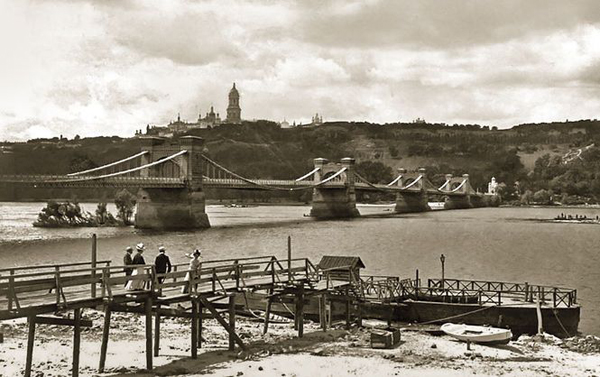 |
| Nicolas Chain Bridge, Kyiv, end of. ХІХ century |
The convoy of Red Haidamakas, Sich Riflemen and others had to fight through the Chain Bridge, as Kyiv Bolshevik rebels set up outposts along the bridge. 20 Haidamakas and Nalyvaiko troops were killed or injured in battle for the bridge; Sich Riflemen lost 4 men, another 8 were injured.
Red Guard lost about 50 people — dead or injured – and left 4 cannons and 12 machine-guns behind. Haidamakas and Sich Riflemen captured 33 Red Guards.
At 7 pm January 19 (February 1) Black Haidamaka Battalion, among other troops of Symon Petliura, entered Kyiv.
The next day Black Haidamakas rushed into battle with the Red Guard in Pechersk. They moved along Staronavodnytska Street, through Zvirynets district, to Vasylkiv fortifications, where located the quarters of Taras Shevchenko Regimen who had declared neutrality.
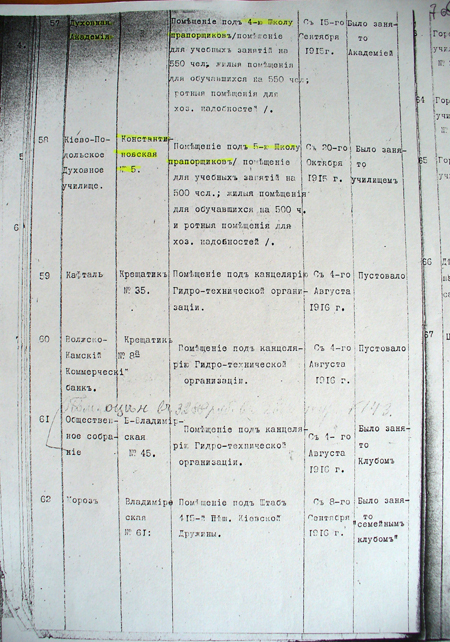 |
| "List of buildings and structures allocated for headquarters and troops accommodation", states that the 5th (typo) Junior Officer School, was quartered at the Kyiv Theological Academy in Podil. Document provided by researcher Yaroslav Tynchenko |
"So we approach a huge new building with a white flag flapping over it… Some soldiers look down from the windows… we fire a few "intimidating" shots, come closer to the gates, and, what a shame! the plate on the gate reads: "Taras Shevchenko Infantry Regiment", — that’s who’s put up the white flag as sign of "neutrality, right when Ukrainian blood is being shed near Arsenal. The guards, as soon as they saw us, quickly left the courtyard, where the grey mass of "Shevchenkivtsi" started to flock.
We lay down behind machine-guns, barrels turned up in the air. Haidamakas surrounded the building.
Our commander tells the guards to call the regiment Commander. Some officers come out.
— What does your neutrality mean? — Our Commander asks. — And why doesn’t the regimen defend the Ukrainian Republic?
— We don’t want to intervene… whoever wins — we’ll follow! — They say derisively.
— We will disarm you! — Our Commander says.
— You can try, but we are not going to fight, nor will we stand in your way.
What should have we done with them? And there was too little time; the battle near Arsenal was getting worse. So we left them, as they promised not to fight against us. And moved along, disarming all kinds of gangs along the way."
On February 2 the company of Sotnik (Captain) Blavatny focused on disarming the 3rd Air Depot in Zvirynets district. This military base was considered one of the most Bolshevik infiltrated among Kyiv military units.
The most hostile to Central Rada Air Depot troopers settled in position in Pechersk. They engaged in fight with Petliura’s Red Haidamaka column, which was moving towards "Arsenal". Red Haidamakas crushed the Air Depot resistance and captured their quarters. Bolsheviks supporters laid down their weapons.
"By decision of their Revolutionary Committe the stuff of the 3rd Air Depot retreated — some to Demiyivka to join the railwaymen, some moved across the Dnieper river to join the Red Guard, which was coming to the aid of Kyiv workers who rebelled against the Central Rada", — later wrote a Soviet memoirist.
On February 3, Blavatny’s troops continued their offensive; their target was to join in the siege and storming of rebel factory.
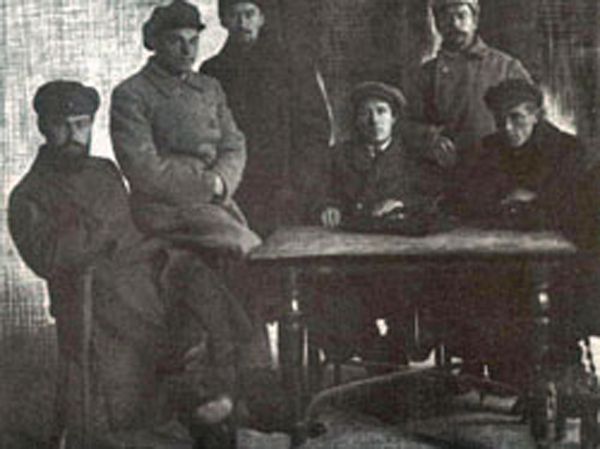 |
|
Leaders of Bolshevik uprising at "Arsenal" Factory in January 1918 in Kyiv. The 1st on the left — Yan Gamarnyk, 4th on the left — Andrey Ivanov . Photo from the funds of the Central Film Phono Photo Archive of Ukraine
|
In the morning of Januray21 (February 3) Petliura arrived at the "Arsenal". Meanwhile, captains Smovsky and Khyzhniak brought two heavy cannons. The storming was supposed to start following the shelling, and executed by three groups:
The 1st group, major, headed by Petliura was made up of Red Haidamakas, part of Nalyvaiko Regiment and the 2nd Battalion of Khmelnytsky Regiment, with total number of 400 troops.
It was supposed to breach "Arsenal" from Mykilska (now Ivan Mazepa) Street and the monument to Kochubei and Iskra.
The 2nd group — 250 troops of Kost Gordienko Regiment lead by Colonel Vsevolod Petriv — was supposed to create a diversion with demonstrative attack from Oleksandrivska Street.
The 3rd group was ordered to storm "Arsenal" from Moskovska Street, and to clear the quarters of the 1st Battaliobof Bogdan Khmelnytsky Regiment so they won’t be hit by artillery fire.
This group was made up of Black Haidamakas, Doroshenko Regiment, and incomplete (one platoon stayed to guard the Chain Bridge) 1st Company of Sich Riflemen with total number of 500 troops. The group was headed by Black Haidamakas Commander Captain Blavatny.
During the first stage of storming Ukrainian troops tooke over the barracks of neutral pontoon brigade, who were providing assistance to "Arsenal". While troops of the first and second groups were seizing the barracks, the third group launched an assault from Moskovska Street.
General Kyrei — one of the best artillerists of the Imperial Russian Army, who took part in the assault — personally directed the artillery fire. Cannons soon breached the walls of the "Arsenal" building; Black Haidamakas and Sich Riflemen immediately moved in through the breaches.
That’s how Colonel Petriv saw the site of assault immediately after the fight: "Moskovska Street near Arsenal is covered in broken window glass, with several corpses lying around. Black trickle of fuel oil is oozing out of a reserve tank, spreads all over the floor, and spills out on the street; to one of the corpses: familiar picture of the rule of tough god of battle — Wuotan".
|
Hand-to-hand combat in workshops and basements lasted till late night. That’s when the last of the Red Guard capitulated. In the storming of "Arsenal" the Ukrainian troops lost over 70 people — killed or injured. Arsenal troops suffered similar losses. Over 100 Red Guards were captured. Two of the Black Haidamakas were killed (one of them Khorunzhy Nezhyvy) and several received injuries.
The POWs were taken to Lavra and locked in nearby barracks.
The very next day, Red Haidamakas lead by Petliura were on their way to storm the Railway Workshops.
Meanwhile, due to Red Guard activity in the neighborhood of Cargo Station (Batyieva Hill), Black Haidamakas, headed by Captain Blavatny, were deployed to the cargo station. Red Guard forces in that section were small, but so were the forces of the UNR defenders. Most of the troops were engaged in Pechersk or the city centre.
Also, Demiyivka Red Guard was joined by some of the Air Fleet Depot troops displaced by Black Haidamakas from Zvirynets district. This allowed for Bolsheviks to capture the Cargo Station. Black Haidamakas followed, and entered into a fight.
"Haidamaka troops fiercely fired at us with machine-guns and shrapnel shells from Cossack yard and nearby houses", — wrote fight participant from the Soviet side about the events at the Cargo Station. In fierce battle of January 21-22 (February 3-4) the station was cleared of enemy troops.
Resistance at the Main Railway Workshops was smashed by Red Haidamaka Brigade and other troops. On January 22 (February 4), 1918, Ukrainian troops finally eliminated the seven-day uprising of the Red Guard.
However, despite defeat, the latter did achieve its goal.
With this treacherous stab in the back of the Ukrainian Republic, the rebels pulled back the finest troops of Central Rada, that were forced to deal with the uprising, while the troops of the Soviet Russia approached the capital.
The major battle was still ahead: the Muravyov’s army approached the bridges over the Dnieper River, and was ready to enter Kyiv.
On January 23 (February 5) mortal combat for the UNR capital city began. Haidamaka Brigade of Sloboda Ukraine tasked with controlling the city center, assumed position at the building of Merchant Assembly (now - the National Philharmonic of Ukraine –IP).
Red Haidamakas maintained contact with the Galicia and Bukovina Sich Riflemen Brigade, stationed at St. Michael's Golden-Domed Monastery, and Black Haidamaka Battalion, that was quartered for rest on the premises of Theological Academy at Kontraktova Square.
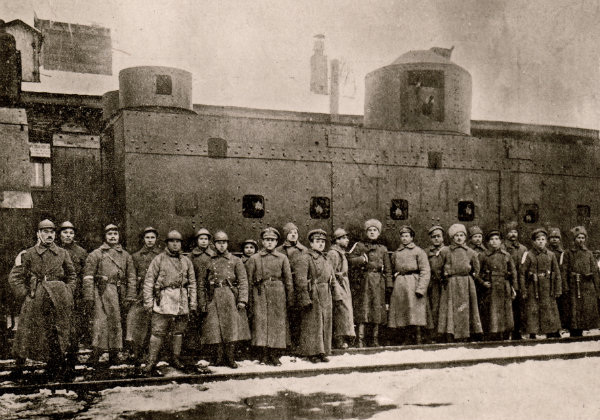 |
| Armored train "Strilets" (Rifleman or Shooter- tr.; also mentioned in the literature as "Sichovy Strilets" – Sich Rifleman) and its service personnel, Kyiv, 1918 |
At night of January 23 (February 5) - January 24 (February 6), 1918, the 1st Red Cossack Regimen headed by Vitaliy Primakov (200 "Cossacks") started on its march to Kyiv.
As soon as they reached the right bank, Bolsheviks marched through Pushcha-Vodytsia and Kurenivka, and entered Podil.
Local Red Guard was joining them along the way.
With no extra losses Primakov and his "Cossacks" took over the premises of the 2nd Military School at the Theological Academy.
|
On January 23 (February 5) the Soviet troops made it to Pechersk, and on February 6 the enemy avant-garde posed a threat to the Cargo Station. It was the Black See Unit headed by Andrey Polupanov. Since it got more and more difficult for Black Haidamakas to withstand enemy’s attacks, they were strengthened by armored train and Volunteer Unit of Colonel Kostiantyn Prisovsky.
In general, on February 6 Muravyov Army occupied all of Podil, most of Pechersk, and Post-Volyskyi Train Station.
However, on January 25 (February 7) the Soviet troops also took over the Cargo Station. Sich Riflemen, who were supposed to re capture the Station, failed to arrive due to lack of coordination.
That same morning, the troops of the 2nd Bolshevik "Army" of Reinholds Bērziņš, that had entered Kyiv through the Chain Bridge a day before, marched to Poshtova Square and arrived at Podil; from there they moved up Oleksandrivsky (now Volodymyrsky) Descent.
Haidamakas who were guarding the Tsarsky Park near the Merchant Assembly greeted Bolsheviks with machine-gun fire and forced them to retreat.
By the end of the day, the advancement of the Soviet troops was stopped everywhere around Kyiv, however, many of the districts had already been under their control. The fight kept going near the Merchant Assembly, were Haidamakas were holding positions, near Arsenal, and at Velyka Vasylkivska Street.
Due to the fact, that all the train stations, Podil, most of Pechersk and part of the City Center was occupied by Red Guard, and to avoid complete encirclement of the Government and the Army, the Ukrainian authorities announced evacuation.
At night the Central Rada with some of the military units retreated along the only open rout - Brest-Lytovsk road (now – Peremohy Avenue). To ensure successful evacuation, the rest of the troops were supposed to hold the front line till the next day: Merchant Assembly – Tsarska (now European) Square – Khreshchatyk – Bibikov Boulevard (now – T. Shevchenko Boulevard) – Brest-Litovsk road.
On January 26 (February 8) only last rear guard troops kept fighting in Kyiv, while the rest continued their retreat to the Western neighborhoods of the city. "Muravyov’s Army" advanced from three directions: Arsenal, Podil, and Velyka Vasylkivska Street.
In the afternoon free Cossacks and separate units that had been defending Khreshchatyk started to retreat. They were almost completely surrounded, but managed to escape due to iron will of Haidamaka Kish, who kept fighting Bolsheviks that were moving in from both directions – Pechersk and Podil. Haidamakas were too tired to even walk.
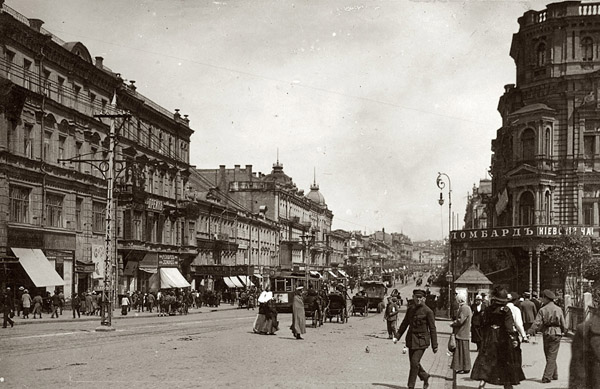 |
| Khreshchatyk, 1918 |
Once our assault was so swift, Bolsheviks didn’t have time to jump on bridges connecting the Gardens; so we killed lots of them there. The whole garden was covered in dead bodies. This running in circles, with not even a minute of rest at daytime or at night, got everyone extremely tired. Meanwhile, the Red attacks were getting pushier.
Tired Haidamakas were just fighting off the enemy, unable to launch an attack. They were so tired, they got worried: "Why aren’t they sending us help? How long are we going to fight here?" Those were the last days and our last attacks.
Ataman Petliura gathered us and spoke: "We need to spare no effort, just one more time!" That was a crazy attack – violent and ruthless. Many Haidamakas perished in this battle, no one escaped a bullet. Haidamakas couldn’t even walk anymore; tired and injured, they crawled around the garden, but no one wanted to leave his brethren. It had all long surpassed any threshold of human abilities".
The last offensive forced Bolsheviks, moving in from Podil and Pechersk direction, to retreat to a greater distance. Haidamakas and troops of the Republican Officer Unit of Captain Petro Bolbocean were able to join forces and retreat together.
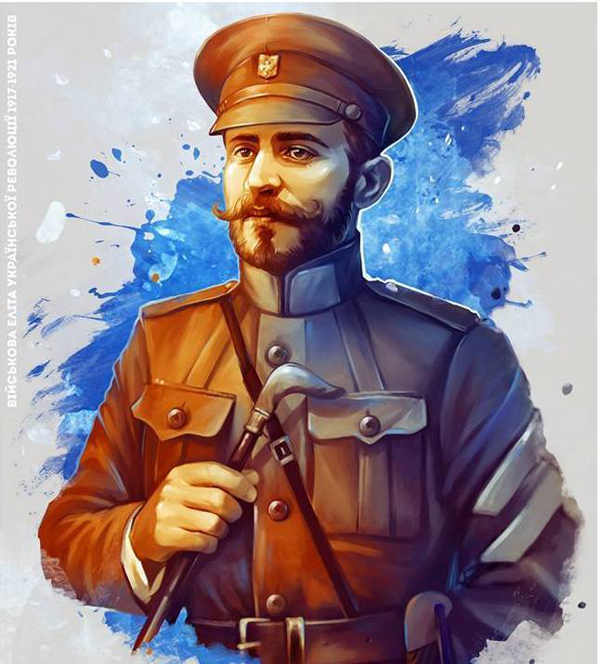 |
|
Petro Bolbocean – Ukrainian military leader, Colonel of the UNR Army. Reconstruction: Ukrainian Institute of National Remembrance |
As soon as the troops passed Galytska Square (now — Peremogy Sq.), they got to the retreat route — Brest-Litovsk road. Along the way, Free Cossacks joined the Haidamakas, and officer unit, which successfully held the fort against the 1st Red "Army" of Yegorov in the city center, joined the republicans.
Haidamaka Kish and other units of the Central Rada reached the village of Gnativka before dark. There, the Government establishments and accompanying military units were waiting for them. It was in this village that on January 27 (February 9) the remains of the UNR armed forces were combined into the first real regular army of the new state — Separate Zaporizhzhia Force.
Haidamaka Unit of Sloboda Ukraine (about 200 troops) remained outside this military structure and spent the night in the village of Shpytky at millionaire Tereshchenko’s estate. It had the following structure: Red Haidamaka Battalion (Kurin), Black Haidamaka Battalion (cadets of the 2nd Ukrainian Military School), Ataman Cavalry Squadron. Several Free Cossacks also joined the Battalion.
The Ukrainian Army of total 3 thousand troops started to advance west where they were supposed to meet with the Austro-Hungarian and German troops, summoned to Ukraine by the Central Rada under the terms of the Treaty of Brest-Litovsk.
Zaporizhzhia troops and Haidamakas freed the towns of Zhytomyr, Korosten and Sarny, they fought a bloody battle for Berdychiv against the Rivne Red Guard of Vasily Kikvidze.
In Berdychiv the Separate Zaporizhzhia Force encountered first German troops. The latter were haunting down former Russian Army units who sided with Bolsheviks.
In the meeting of commanders at the town of Malyn of the present Zhytomyr Oblast Symon Petliura secured the right to be the first to enter Kyiv, ahead of the German troops. Haidamakas and Sich Riflemen led by Petliura immediately launched the attack via the rail route Korosten—Kyiv.
The first battle for the capital city took place near the village of Bukhtiyivka (now — Sadky village at Radomyshl raion of Zhytomyr Oblast). The battle caused the Soviet troops to retreat as far as Irpin Station. In battles for Irpin and Bucha Haidamakas once again encountered Kikvidze.
Bolsheviks attempted a counterattack, as they had cannons, but Petliura’s troops held their position and defeated them. The road to Kyiv was clear. On March 1, 1918, (Gregorian Calendar) at about 10 am Zaporizhzhia Force and Haidamaka Unit of Sloboda Ukraine returned to Kyiv.
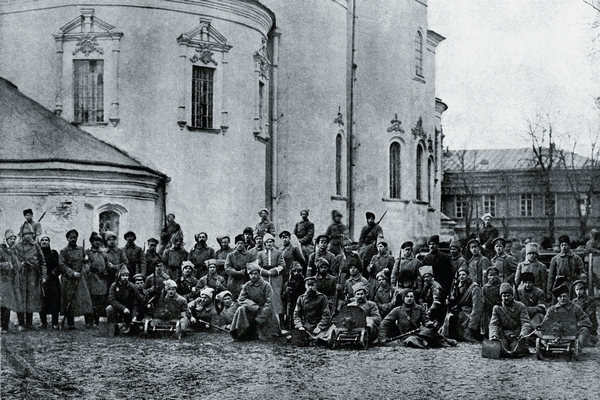 |
| Symon Petliura with officers and personnel of the 3rd Haidamaka Regiment— former Haidamaka Kish of Sloboda Ukraine of the UNR Army, early March 1918. Apparently, there are Black Haidamakas in the picture |
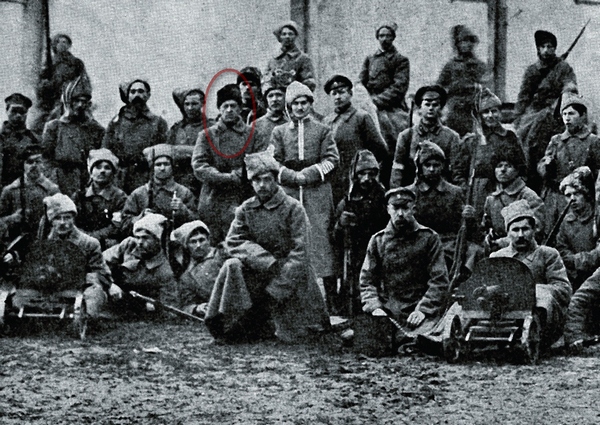 |
Vigorous work on rebuilding the state apparatus and the armed forces had started. Haidamaka Brigade of Sloboda Ukraine became part of the newly established 3rd Haidamaka Regiment of the Separate Zaporizhzhya Division. The letter was formed on the base of Zaporizhzhya Force.
Black Haidamaka Battalion (Kurin) joined the new army – it turned from unique, half-guerilla unit of Sloboda Battalion into part of the regular UNR Army. Soon after freeing Kyiv, the 3rd Haidamaka Regiment headed by new commander Oleksandr Udovychenko left to free Poltava and Donbas Regions from Bolsheviks.
Junior cadets of the Military School, who had not been deployed to Haidamaka Unit in the meeting of January 14 (Julian calendar), 1918, were enlisted as one-year volunteers (which meant that they had the right to receive their first officer rank within a year) to various regiments of Haidamaka Kish, or enlisted to civil service or higher schools.
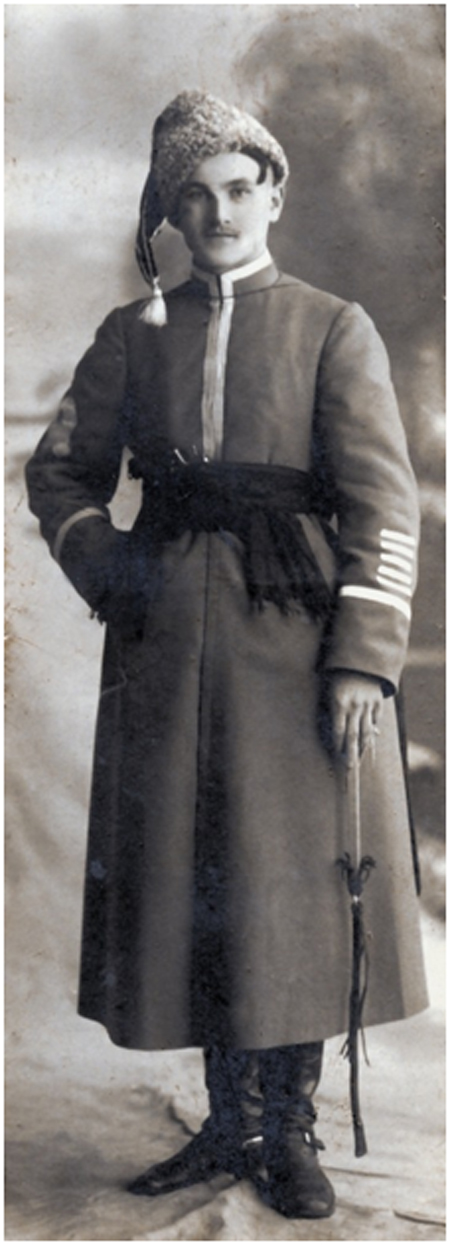 |
| Officer of Black Haidamaka Kurin Captain Oleksandr Saveliev, March 18, 1918 |
